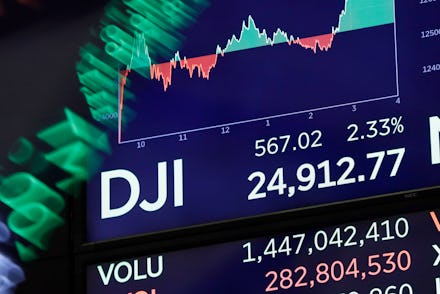Dow Jones today: Why the stock market had a mini-freakout about the inflation rate — then recovered

What started as a positive week for the stock market took a turn Wednesday morning after the Department of Labor released new inflation data showing consumer prices rising more than expected. After climbing for three straight days following last week’s scary sell-off, the Dow Jones industrial average opened 0.42% lower. Then by noon the index had flattened back out, and by market close it was up more than 1% for the day.
Why did the market hiccup — then shrug?
Before the report came out, stocks were expected to climb when markets opened. But as the news about the consumer price index broke, expectations immediately swung into the negative, according to Reuters. Dow futures — where traders bet on future stock movements — fell roughly 480 points. Consumer prices rose across the board, according to the Labor Department’s new numbers, with food, energy, housing and health care costs all climbing.
One reason stocks reacted so negatively (if briefly) is investors fear prices might continue to climb faster than expected, which could mean the Federal Reserve will intervene by raising interest rates — aka the cost of borrowing money — more quickly than anticipated.
Higher rates would put pressure on stocks, in part because skittish investors might start moving their money to bonds, as less-risky fixed-income investments could start to pay more.
Yet perhaps more disconcerting is a report from Bloomberg that suggests much of the stock market’s recent three-day winning streak was driven by companies buying back shares in their own business. While these buybacks, which increase value for shareholders, account for much of the market’s gains since the recovery, Goldman Sachs calculated last week’s corporate-trading volume was especially high: 4.5 times the daily average from 2017.
In other words: Even as it turns positive, the stock market might be softer than it appears on the surface. After all, investors are anxious about more than inflation. There’s also geopolitical risks and the fact that stocks are historically expensive.
Investors can also get nervous when volatility — a measure of how much and how quickly prices change — climbs too abruptly. Some volatility is healthy, but too much makes people hesitant to invest. That’s why the recent uptick is worrisome: The VIX index, which tracks volatility, remains the highest it has been since the 2016 presidential election. “Volatility shocks” have foreshadowed slower economic growth, or even a contraction, three times since 1998, Bloomberg’s Ben Emons wrote.
But on the bright side? Volatility can help ease inflation.
Plus, some economists point out that while month-to-month prices changes missed expectations, the year-to-year downtrend in inflation is more important. After all, inflation is still below the Fed’s 2% target, suggesting the Fed might feel less pressure to raise rates quickly — a point Jay Shambaugh, who served as an adviser to former President Barack Obama, made on Twitter.
Another encouraging data point: One reason prices are rising might be because the economy is getting stronger. On Tuesday, the S&P’s ratings agency lowered its risk assessment for the next U.S. recession, saying the odds of significant economic decline — lasting longer than a few months — is between 10% and 15%, down from 15-20% in November.
That’s good news. However, like all projections, it should also be taken with a grain of salt. After all, if there is a decline, policymakers aren’t as equipped as they once were to weather a recession: Two previously used tools — slashing interest rates to encourage borrowing and cutting taxes to put money into people’s pockets — have already been taken off of the table.
Sign up for the Payoff — your weekly crash course on how to live your best financial life.
Feb. 14, 2018, 4:00 p.m. Eastern: This story has been updated.